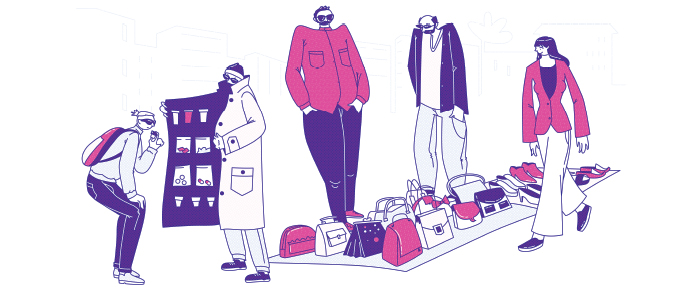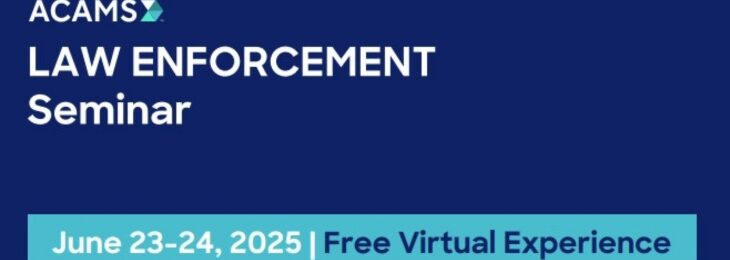
The rapid growth of business activities—such as buying and selling raw materials, manufacturing goods and trading—and the increased demand for goods have revolutionized the way these goods are manufactured and sold across borders. Therefore, the global nature, high-profit scales and lower chance of being detected have created new opportunities for criminal groups to trade goods illicitly, which puts consumers at high risk.
The Trade of Illicit Goods
Globalization, population growth and interconnected societies and economies create improved lifestyles, which unfortunately also creates opportunities for organized criminal networks to enter the area of legal goods (e.g., clothes, bags, medicine, automobile parts) through the purchase of fake or expired raw materials or illegal manufacturing processes and introducing the finished goods into legal markets and shopping malls for consumers to purchase unknowingly.
A wide range of illicit goods is manufactured and sold by criminal groups, including consumer electronics, food, drinks, agricultural products, chemicals and pesticides, automotive goods, pharmaceuticals, tobacco, household items and more. These illicit producers and substandard manufacturers negatively impact legitimate companies and government revenue.
The following are examples of what constitutes illicit goods trade:
- Copies of branded goods: Fakes that look like the original product
- Purchase of pirated raw material: Using the closest copy of an original raw material to disguise the origin of the illegal good
- Illegal manufacturing and logistics: Transforming fake goods and moving them from the raw material stage through their destined markets
- Sale of illegal goods to the target markets: Adopting marketing and sales strategies, e.g., product promotions and offering discounts to target customers
Interlinkage with Other Crimes
The trade of counterfeit goods includes a diverse range of products. Thus, criminal networks use the routes they have already established to smuggle drugs and people and commit other crimes. Furthermore, proceeds of other crimes also feed into the production and distribution of illegal goods. For example, proceeds from drug trafficking can be channeled into counterfeiting goods, and profits from the sale of illicit goods can be used to further other illegal operations. Organized criminals also frequently exchange goods (e.g., swapping drugs for pirated or substandard items and vice versa) as full or partial payments amongst themselves, resulting in reduced capital movement across borders and consequently reducing the risk associated with the trade of illicit goods.
Illicit Trade Factors
The major perpetrators of illicit trade are businessmen who operate legitimately registered companies that move illicit items through shipments containing undeclared or falsely declared goods or through cross-border smuggling. Corrupt officials and porous borders are key enablers of illicit trade flows. According to Karl Lallerstedt, a member of the OCED Task Force on Countering Illegal Trade, “Illicit financial flows: Illicit trade in counterfeit, pirated and substandard goods in Ghana,” the following are factors that facilitate illicit trade:1
- Corruption networks: The trading sector is vulnerable to corruption; it is often a source of inaccurate and unreliable data on counterfeit goods.
- Weak law enforcement: Lack of enforcement legislation leaves illicit trade to be detected and contested in courts. Spot checks and retail controls are also found to be largely ineffective.
Trafficking illicit goods is a crime that leads to significant social, ethical and health consequences for virtually all of society
- Weak border controls: The porous nature of borders, trade facilitation between trading borders and corruption within customs services and border controls all make illicit trade easy to conduct.
- Illicit trade at the local and international level: Banks and financial institutions (FIs) process illicit transactions for illegal trading activities around the world.
Trafficking illegal goods is more profitable than other illicit activities, such as the sale of narcotics and weapons, because it is difficult to detect and perceived as low risk. The trade of fake and pirated goods is run by extensive and complex criminal enterprises and networks.
It is also perceived to be a lesser crime because the penalties and sentences are weaker. Developing countries generally have severely limited resources and abilities to address illicit goods trade and its financial flows.2 The main motivating factors behind the trade of illicit goods are low risks to commercial portfolios, which decrease the probability of being detected, and large profits from the high demand for certain commodities.
Illicit Practices
Traffickers of illicit goods adopt various practices, including the following:
- Counterfeiting: The process of bearing a trademark without the consent of the trademark’s owner on fake goods.
- Piracy: The act of reproducing movies, books or other copyrighted works without permission from the copyright owner.
- Falsification: An act of disproving a proposition or theory or claiming incorrect information.
- Adulteration of products: The process of manufacturing lower quality products by adding inappropriate substances.
- Tax evasion: The deliberate avoidance of paying true tax liability or taking advantage of free trade zones (FTZs) for illicit goods trade.
- Smuggling: The illegal movement of genuine products.
The Consequences of Trading Illicit Goods
Trafficking illicit goods is a crime that leads to significant social, ethical and health consequences for virtually all of society. The following are the consequences of trading illicit goods:
- Threat to public health and safety: Counterfeit and fraudulent medicines pose a serious risk to public health and safety due to pirated or substandard raw materials and chemicals. Without regulation, consumers’ lives are put at risk, which can lead to injury or death.
- Negative economic impact: Trade of illicit goods undermines economic development. Smuggling, false declaration of imports and excise and customs fraud reduce government revenue. They also generate unfair competition for legitimate companies due to the availability of a wide range of lower-cost pirated, counterfeit and substandard products in the market, which negatively impacts jobs and investments.
Illicit trade undermines the legitimate competitive advantage of rights holders and hampers innovation, employment and long-term economic growth
- Labor exploitation: Exploiting labor through employment rights, decent pay and working conditions is another consequence of trading illicit goods. Jobs in the production of fake and pirated goods can be unregulated, offer less pay, offer no benefits and create unsafe and insecure labor environments. Smuggled migrants, including children, are coerced into producing and selling illicit goods and become victims of labor trafficking.
- Environmental impact: The environmental costs of counterfeiting and substandard goods are usually understated. The production of counterfeit goods lacks regulation, which can be detrimental to the environment. The use of chemicals and toxic dyes, unlawful disposal of used manufactured goods and unregulated air pollution all contribute to the destruction of the environment.
Enforcement Challenges to Counter Illicit Goods Trade
Illicit trade undermines the legitimate competitive advantage of rights holders and hampers innovation, employment and long-term economic growth. It also weakens the rule of law and citizens’ trust in government.
Uncoordinated governments’ response toward illicit trade risk and enforcement gaps can be easily exploited by organized criminal networks. It is time for governments and relevant competent authorities to address these challenges by doing the following:
- Enhancing the effectiveness of penalties and sanctions for countering illicit trade: It is important to implement legal frameworks to counter illicit trade both nationally and internationally. International conventions, laws and agreements govern the global efforts (e.g., the United Nations Convention against Transnational Organized Crime and the World Trade Organization’s Agreement on Trade-Related Aspects of Intellectual Property Rights). National legal frameworks include principal and ancillary legislations. National policies and programs must be enhanced and enforced to punish and deter crime with increased penalties and sanctions on illicit actors.
- Improving screening to detect the rising volume of small shipments of illicit products: Governments must assess the accuracy of the information, such as advance commercial information, declaration and description of the products arriving that may lack details, etc. The role of intermediaries and vendors, like postal workers and couriers, who are the source of small illicit shipments, must be screened by governing authorities.
- Eliminating criminal activities related to illicit trade carried out in FTZs: In order to control illicit trade through FTZs, governments should operate with adequate standards for business registration practices. Policies with a coordinated approach among all economies can be an effective tool to combat illegal trading activities in FTZs.
The Role of TBML
According to the Financial Action Task Force (FATF), trade-based money laundering (TBML) is one of the primary ways criminal organizations launder illicit proceeds through trade transactions.
Common TBML typologies include over-invoicing and under-invoicing, multiple invoicing, over-shipping and under-shipping, and falsely describing goods and services.
Illicit goods trade leaves a profound impact on societies worldwide because it is an organized and global crime
According to the U.S. Government Accountability Office, trade transactions are difficult to monitor due to their complex nature and volume, and banks often do not receive trade documents, especially those of open account trade. These documents may signal potential criminal activity, which banks could report for further investigation. The U.S. financial and trade system allows for open account trade in which banks do not finance the transaction—the transaction would be completed between the buyer and the seller. In addition, a bank submits the payments on behalf of its clients through an automatic payment system and without human intervention. Criminal organizations commingle legitimate trade with illicit trade to complicate detecting suspicious activity.
Conclusion
Illicit goods trade leaves a profound impact on societies worldwide because it is an organized and global crime. Therefore, it is high time to address the enforcement challenges to control these criminal activities at the core level and have FIs address the illicit goods trade via TBML.
Syeda Mehar Zehra, CAMS, MLRO and head of AML/CFT and Sanctions Compliance, HBL Currency Exchange—Pakistan, syedamehar15@yahoo.com, ![]()
- Karl Lallerstedt, “Illicit financial flows: Illicit trade in counterfeit, pirated and substandard goods in Ghana,” OECD iLibrary, December 3, 2019, https://www.oecd-ilibrary.org/docserver/113ce3d6-en.pdf?expires=1660163482&id=id&accname=guest&checksum=13DD95955E6F2338454F7DF88AB9FABB
- Ibid.










